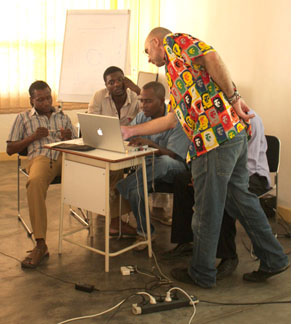DESIGN OF PATTERNS IN MOZAMBIQUE
The 2nd year students in Design working on their computers. All of them have their own computer in some form and software to experiment with patterns and form.
Maputo is a very vibrant city. I read last year (I think in the Economist – my favourite paper) that Maputo is the most culturally vibrant city in Africa. Well we can believe that if we like but it depends on what is being measured. The measurement does not matter but since I arrived here first time in April 2007, almost exactly four years ago I can confirm this. When I arrived first time the city reminded me of my good old home town Reykjavík in Iceland. There is some kind of a vibe in the place, a mix of hunger for action, so many people are artists, doers, all of them of course dance like a dream (something no white person can imitate). People are so creative here and are not afraid of having a go, – something that I have encountered in one of my other home towns Oslo. There I have often heard the phrase: “Is it allowed?” – Here, and in Reykjavik this is not high on the list of wonderings. People have a go. And only by having a go can one find out if it works (I like here to refer to the excellent lecture by Ken Robinson on TED).
 I have got to know many artists here, actors, musicians and cultural activists, but the least I meet are designers. There are not so many in town – although I properly agree to the phrase: “Everyone is a designer!” And that is true, most of the students in ISArC have been making things of the design type for years. They make clothing, advertising, furniture, product solutions, but without the design education that is common in university academies in Western countries.
I have got to know many artists here, actors, musicians and cultural activists, but the least I meet are designers. There are not so many in town – although I properly agree to the phrase: “Everyone is a designer!” And that is true, most of the students in ISArC have been making things of the design type for years. They make clothing, advertising, furniture, product solutions, but without the design education that is common in university academies in Western countries.
Sadly some of the culture here is nowadays flooded by very bad design, advertising, furniture from the incredibly capitalistic driven South Africa, that does not respect this culture in any way. I regularly meet South Africans that talk very degradingly about the conditions here, while not seeing the capitalistic driven slavery that keeps their own economy so vibrant, while being very flat and unimaginative in terms of design solutions.
Anyway, enough of brooding. The most important here in Maputo is the positive hunger for action, design and production. My students are making capulana design at the moment, commissioned by the Mozambican train company: Mozambique Ports and Railways . We are having fun making patterns, flipping forms, repeating, discussing production methods etc. Interestingly I did actually give a presentation about capulanas for my students of fashion in Oslo just few weeks ago. I post here a few images from the class activity.
Concentration making capulana patterns.
The capulana is a textile garment mostly worn by women in Mozambique, while it is more worn by men in Asia. It resembles a long skirt, the garment consists of a long piece of material wound around the lower half of the body from the waist to the ankles. Women sometimes wear the capulana so that its upper edge reaches the middle of the chest, tightly covering it. They are made of colored cotton and originate from the islands of Java and Bali. They are usually made of roll batik, using wax and colour dies. Similar garments are common over Africa and Asia with different types of names.
 March 30, 2011
March 30, 2011
 Tags: academy, art, capulana, DESIGN, maputo, mozambique Posted in: DESIGN, FASHION, ISAC - KHiO, PONDERINGS
Tags: academy, art, capulana, DESIGN, maputo, mozambique Posted in: DESIGN, FASHION, ISAC - KHiO, PONDERINGS



